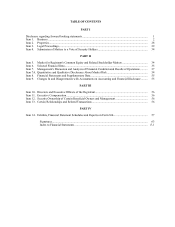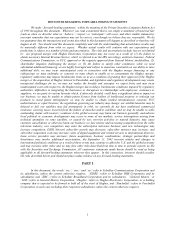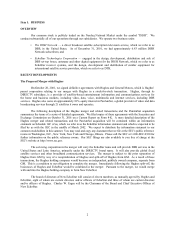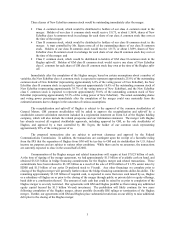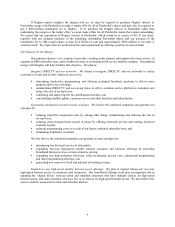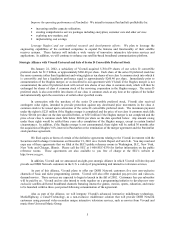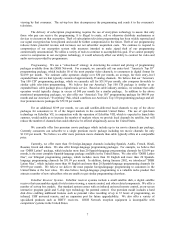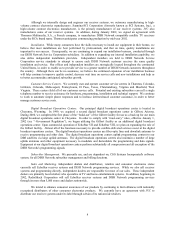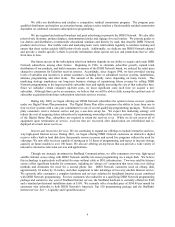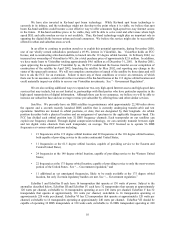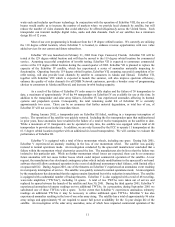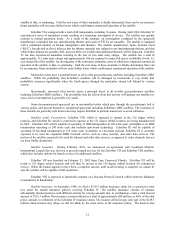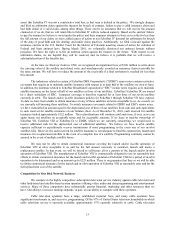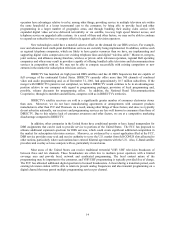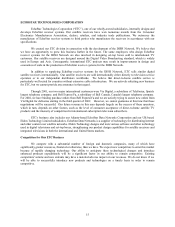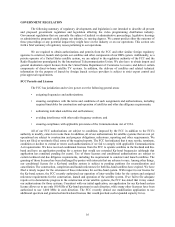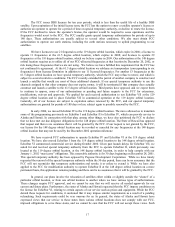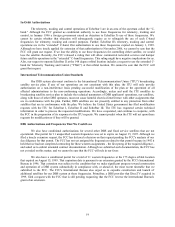Dish Network 2001 Annual Report Download - page 12
Download and view the complete annual report
Please find page 12 of the 2001 Dish Network annual report below. You can navigate through the pages in the report by either clicking on the pages listed below, or by using the keyword search tool below to find specific information within the annual report.10
We have also invested in Ka-band spot beam technology. While Ka-band spot beam technology is
currently in its infancy, and the technology might not develop to the point where it is viable, we believe that spot
beam Ka-band satellites could become a cost effective way to offer consumers high-speed two-way Internet access
in the future. If Ka-band satellites prove to be viable, they will be able to serve rural and other areas where high
speed DSL and cable modem service is not available. Thus, Ka-band technology might play an important role in
spanning the digital divide between urban and rural consumers. We believe the service might also be successfully
offered in urban and suburban areas as well.
In an effort to continue to position ourselves to exploit this potential opportunity, during November 2000,
one of our wholly owned subsidiaries purchased a 49.9% interest in VisionStar, Inc. VisionStar holds an FCC
license, and is constructing a Ka-band satellite, to launch into the 113 degree orbital location. In February 2002, we
increased our ownership of VisionStar to 90%, for a total purchase price of approximately $2.8 million. In addition,
we have made loans to VisionStar totaling approximately $4.6 million as of December 31, 2001. In October 2001,
upon approving the acquisition of VisionStar by us, the FCC conditioned the license transfer on our completion of
construction of the satellite by April 2002, launching the satellite by May 2002, and reporting any change in the
status of the spacecraft contract. We will not complete construction or launch of the satellite by those dates and will
have to ask the FCC for an extension. Failure to meet any of these conditions or receive an extension, of which
there can be no assurance, could result in the revocation of the Ka-band license at the 113 degree orbital location and
could materially impact our ability to recover our VisionStar investments. See “– Government Regulation”.
We are also seeking additional ways to expand our two-way high-speed Internet access and high-speed data
services that may include, but are not limited to, partnerships with third parties who have particular expertise in the
high speed transmission of digital information. Although there can be no assurance, we believe we will be able to
increase our subscriber base and our average revenue per subscriber by offering these and other similar services.
Satellites. We presently have six DBS satellites in geostationary orbit approximately 22,300 miles above
the equator and a seventh recently launched DBS satellite that is currently undergoing transfer-orbit and test
operations. Satellites are located in orbital positions, or slots, that are designated by their longitude. An orbital
position describes both a physical location and an assignment of spectrum in the applicable frequency band. The
FCC has divided each orbital position into 32 DBS frequency channels. Each transponder on our satellites can
exploit one frequency channel. Through digital compression technology, we can currently transmit between eight
and ten digital video channels from each transponder, on average. The FCC licensed us to operate 96 DBS
frequencies at various orbital positions including:
•21 frequencies at the 119 degree orbital location and 29 frequencies at the 110 degree orbital location,
both capable of providing service to the entire continental United States;
•11 frequencies at the 61.5 degree orbital location, capable of providing service to the Eastern and
Central United States;
•24 frequencies at the 148 degree orbital location, capable of providing service to the Western United
States;
•22 frequencies at the 175 degree orbital location, capable of providing service to only the most western
portion of the United States. See “— Government regulation;” and
•11 additional as yet unassigned frequencies, likely to be made available at the 175 degree orbital
location, but only if certain regulatory hurdles are met. See “— Government regulation.”
EchoStar I and EchoStar II each have 16 transponders that operate at 130 watts of power. Subject to the
anomalies described below, EchoStar III and EchoStar IV each have 32 transponders that operate at approximately
120 watts per channel, switchable to 16 transponders operating at over 230 watts per channel. EchoStar V has 32
transponders that operate at approximately 110 watts per channel, switchable to 16 transponders operating at
approximately 220 watts per channel. EchoStar VI has 32 transponders that operate at approximately 120 watts per
channel, switchable to 16 transponders operating at approximately 240 watts per channel. EchoStar VII should be
capable of operating 32 DBS transponders at 120 watts each, switchable to 16 DBS transponders operating at 240


